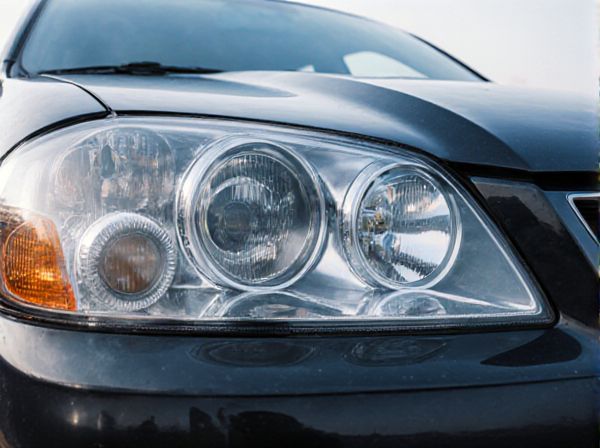
Photo illustration: Halogen Bulb vs Xenon Bulb
Halogen bulbs produce a warm, yellowish light and are more affordable with a shorter lifespan compared to xenon bulbs. Xenon bulbs emit a brighter, whiter light that enhances visibility and offers better energy efficiency, making them ideal for improved night driving. Choosing the right bulb depends on your preference for cost, brightness, and longevity in your vehicle's lighting system.
Table of Comparison
| Feature | Halogen Bulb | Xenon Bulb (HID) |
|---|---|---|
| Light Output | Up to 1,500 lumens | Up to 3,500 lumens |
| Color Temperature | 2,700K - 3,200K (yellowish) | 4,000K - 6,000K (white to bluish) |
| Energy Efficiency | Low efficiency, higher power usage | High efficiency, lower power consumption |
| Lifespan | 500 to 1,000 hours | 2,000 to 3,000 hours |
| Cost | Low upfront cost | Higher initial cost |
| Warm-up Time | Instant light | 2 to 3 seconds |
| Installation | Simple, direct replacement | May require ballast and wiring |
Introduction to Halogen and Xenon Bulbs
Halogen bulbs use a tungsten filament enclosed in a small quartz capsule filled with halogen gas, enabling higher temperatures and brighter light output than traditional incandescent bulbs. Xenon bulbs, also known as HID (High-Intensity Discharge) lamps, generate light by passing an electrical arc through ionized xenon gas, producing a more intense and energy-efficient illumination with a characteristic bluish-white hue. Both types are popular in automotive lighting, with halogen bulbs offering affordability and simplicity, while xenon bulbs provide superior brightness and longevity.
How Halogen Bulbs Work
Halogen bulbs operate by passing an electric current through a tungsten filament enclosed in a small quartz capsule filled with halogen gas, such as iodine or bromine, which increases the filament's lifespan and brightness. The halogen gas triggers a chemical reaction that redeposits evaporated tungsten back onto the filament, preventing darkening of the bulb and maintaining consistent light output. This process allows halogen bulbs to produce a bright, white light with high efficiency compared to traditional incandescent bulbs, though they generally have lower intensity and lifespan than xenon bulbs.
How Xenon Bulbs Operate
Xenon bulbs operate by passing an electric current through xenon gas, producing a bright, white-blue light with higher intensity and efficiency compared to halogen bulbs, which use a tungsten filament heated to emit light. The xenon gas ionizes when electrified, creating an arc that generates more lumens per watt, enhancing visibility and beam range. This technology results in longer bulb lifespan and improved energy consumption compared to traditional halogen bulbs.
Brightness and Light Quality Comparison
Xenon bulbs emit a brighter, more intense light with a color temperature around 4,000 to 6,000 Kelvin, producing a whiter and more natural illumination compared to halogen bulbs that typically range from 3,000 to 3,500 Kelvin with a yellowish hue. The increased brightness of xenon bulbs enhances visibility and reduces eye strain during nighttime driving, while halogen bulbs provide adequate lighting but with lower luminance and reduced clarity. Xenon bulbs also offer a broader light spectrum and improved beam focus, resulting in better contrast and sharper vision on the road.
Energy Efficiency Differences
Halogen bulbs consume more energy by operating at higher wattages, typically between 55 to 65 watts, while xenon bulbs (HID lamps) use about 35 watts to produce the same or greater light output, making them significantly more energy-efficient. Xenon bulbs generate brighter and whiter light with lower heat emission, resulting in less energy loss compared to the infrared-heavy output of halogen bulbs. The improved luminous efficacy of xenon bulbs contributes to reduced power consumption and longer lifespan, translating to cost savings and environmental benefits over time.
Lifespan and Durability
Halogen bulbs typically last around 450 to 1,000 hours, while xenon bulbs boast a longer lifespan ranging from 2,000 to 3,000 hours. Xenon bulbs offer enhanced durability due to their robust arc-discharge mechanism, which withstands vibrations and temperature fluctuations better than the filament-based halogen bulbs. The advanced materials and gas composition in xenon bulbs contribute to their superior longevity and resistance to wear.
Cost and Affordability
Halogen bulbs typically cost between $10 and $20 per unit, making them highly affordable for standard vehicle replacements. Xenon bulbs, also known as HID bulbs, range from $50 to $150, reflecting higher manufacturing complexity and enhanced brightness performance. Maintenance and replacement expenses for xenon bulbs are generally greater due to their specialized components and installation requirements.
Installation and Compatibility
Halogen bulbs typically feature a straightforward plug-and-play installation compatible with most vehicle headlamp housings and existing wiring systems. Xenon bulbs, or HID lamps, often require a ballast for proper operation, necessitating additional wiring modifications and potential compatibility checks with the vehicle's electrical system. Ensuring proper fitment and voltage compatibility is crucial to avoid flickering or damage when switching between these two bulb types.
Applications in Automotive and Home Lighting
Halogen bulbs are widely used in automotive headlights and home lighting due to their affordability, ease of replacement, and warm light output suitable for interior environments. Xenon bulbs, or HID (High-Intensity Discharge) lamps, provide brighter, whiter light with higher energy efficiency, making them preferred for premium automotive lighting and outdoor home applications requiring greater visibility. The choice between halogen and xenon bulbs depends on factors such as light intensity, energy consumption, lifespan, and cost considerations for specific automotive and residential lighting needs.
Which Bulb is Best: Halogen or Xenon?
Xenon bulbs provide brighter, whiter light with higher luminosity and longer lifespan compared to halogen bulbs, making them ideal for enhanced nighttime visibility. Halogen bulbs, while more affordable and easier to replace, emit a warmer, yellowish light and have a shorter operational life. For optimal performance, Xenon bulbs are best suited for those prioritizing brightness and durability, whereas halogen bulbs fit budget-conscious users seeking simplicity.
 caratoz.com
caratoz.com